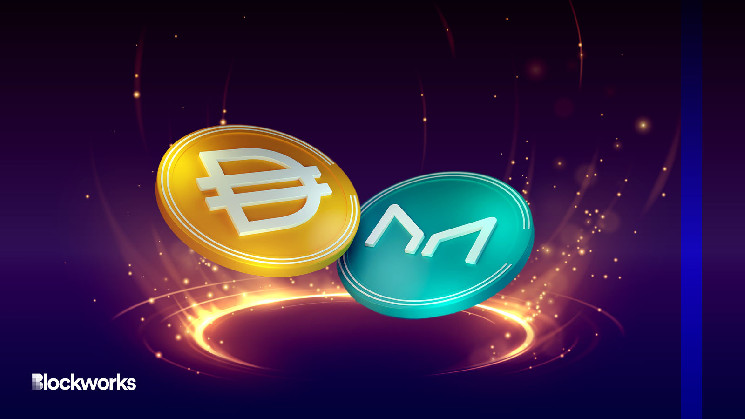DeFi
Maker DAO is synonymous with its dai (DAI) stablecoin, but the DAO has never directly supported front-end access to the offering. Instead, user-facing products have been the purview of third-parties such as Oasis, DeFi Saver and Instadapp.
That’s changing with the launch of Spark Protocol, which will give users access to a wholesale dai credit line directly injected from Maker.
MakerDAO will initially own the product, which is expected to later be spun out into its own sub-DAO, according to Sam McPherson, Co-founder of Phoenix Labs, a research and development company which built the protocol’s smart contracts and front-end.
“MakerDAO is still the ultimate authority, but the sub-DAOs are where the innovation and growth initiatives occur,” McPherson told Blockworks. “You can think of it kind of like a subsidiary of MakerDAO.”
What is Spark Protocol?
The product consists of two components: Spark Lend and its associate front-end interface.
Both the smart contracts and the front-end took Aave’s open-source codebase as a starting point, which were then customized to focus on dai, rather than a general purpose borrowing and lending market.
“One of the main advantages is we get liquidity directly from Maker at the cheapest rate possible,” McPherson said. “This is going to be a big killer feature for the lending protocol.”
Unlike Aave, Spark will have a custom interest rate model that is not variable based on utilization — supply and demand. Instead, the rate is set by governance and remains flat no matter how many users are accessing dai liquidity, right up to a governance-set debt ceiling.
The initial cap will be $5 million, but McPherson expects it to rise to $200 million within two-to-five weeks. The lower starting point is a safety measure.
The first collateral assets on the protocol will be ETH and stETH — Lido’s staked ether token — with additional liquid staked ether tokens (LSTs) to be onboarded in the future.
“The reason we’ve chosen these is because they are decentralized in nature,” McPherson said, noting “the market for Spark is entirely focused on promoting decentralized collateral for Maker Core.”
That’s in contrast to the other stream of collateral assets for backing dai, often referred to as “real-world assets” (RWA) — though some dislike the term.
The decentralized side is Spark’s focus. As for what comes next, it will come down to liquidity and risk assessment. “It looks like Rocket Pool is a likely next candidate,” McPherson said. Block Analytica, a risk team in Maker, provides simulations to inform governance on-boarding decision-making.
In general, the Shapella upgrade was a major de-risking event for LSTs on Ethereum.
With the new ability to redeem ETH from LSTs, “we have much more confidence in these tokens maintaining their peg to ETH, which is very important for setting risk parameters,” McPherson said.
One novel feature of Spark is the availability of a tokenized Savings DAI — dai that’s locked in Maker’s DAI Saving Rate (DSR) module — which will allow users to enter and exit the DSR from the Spark front-end. That means holders of USDC can more seamlessly access the DSR in a way not possible today.
Decentralization details
Ownership of front-end interfaces has become a hot topic, particularly in US political circles, and McPherson said the front-end instance that runs at SparkProtocol.io will need to be compliant with any regulations in major jurisdictions.
However, the code is available on GitHub and anyone can download it and run it themselves.
“It’s very easy to download it and install yourself — and this is the ideal way that everybody should be interacting with it,” he said.
Spark Protocol uses Chainlink oracles rather than Chronicle price feeds used by Maker’s Oracle Safety Module.
Since it will have live price feeds, rather than Maker’s conservative one-hour delay on prices governing liquidations, Spark will run using loan-to-value ratios (LTVs) that are more in line with secondary markets like Aave and Compound.
On the roadmap is the need to harden the oracle system with additional redundancy which McPherson said should happen “in the near future.”
The product launch is “directly in line with the Endgame plan,” he said, for which the goal is to transition Maker Core to basic maintenance role, while other more complex Maker initiatives move into sub-DAOs.
“We’re dog-fooding this process as Spark Protocol in that this is the type of innovation that the Endgame plan is meant to foster within the outskirts of Maker Core.”
Dog-fooding is tech slang for the use of one’s own products. In this case, it’s both a model of how Maker’s practical governance is intended to evolve and a potential source of funds.
Revenue generated by the sub-DAO flows back to Maker Core, to the benefit of MKR holders.
“Spark Protocol is just one of many such innovations that will grow the DAI and Maker ecosystem and help foster this new explosion of DAI and Maker excitement,” McPherson said.



